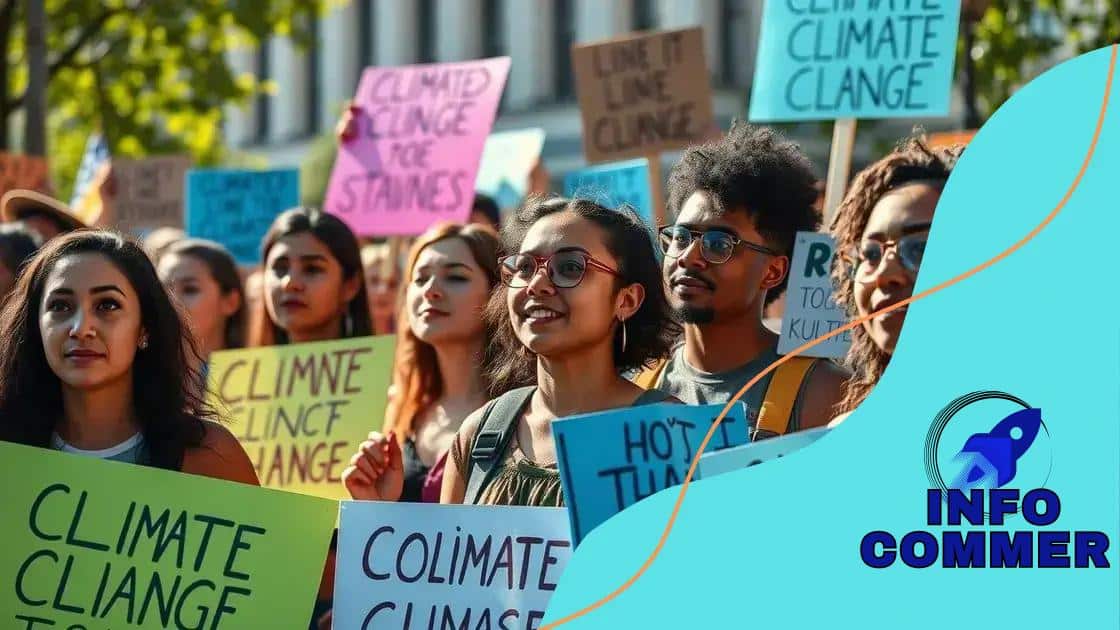Social media’s role in environmental activism

Social media’s role in environmental activism is crucial, enabling rapid information sharing, community building, and global mobilization for various campaigns that address urgent ecological issues.
Social media’s role in environmental activism is becoming increasingly vital for mobilizing support and spreading awareness. Have you noticed how platforms like Twitter and Instagram amplify voices in ways that traditional media often miss? In this article, we’ll dive into the influence of social networks on environmental initiatives.
The rise of social media in activism
In recent years, we have witnessed a significant shift in how activism occurs. The rise of social media in activism has transformed traditional methods into something dynamic and far-reaching. Social platforms allow anyone to amplify their voice and connect with like-minded individuals across the globe.
How Social Media Empowers Activists
Activists now utilize social media to share information, mobilize support, and raise awareness about various issues. This empowerment creates a sense of community among those passionate about change.
- Instantaneous sharing of information
- Mobilization of like-minded individuals
- Increased visibility for marginalized voices
Furthermore, social media platforms can turn local issues into global movements, showcasing stories that resonate on a broader scale. Viral hashtags like #BlackLivesMatter and #FridaysForFuture exemplify how digital spaces can spark real-world actions and discussions.
Impact on Younger Generations
Younger generations are particularly influenced by social media, as they spend significant time online. They often rely on social media for news and information. This behavior shapes their views on social justice and environmental issues, inspiring them to participate in activism.
- Access to diverse information sources
- Immediate feedback and support networks
- Active participation in advocacy campaigns
The accessibility and immediacy of social media make it easier for young people to engage in activism. As new generations take the lead in these movements, we can expect to see even more creative and impactful uses of social media in the fight for change.
As we watch this evolution, it becomes clear that social media will continue to play a crucial role in shaping the future of activism. The ability to unite people around shared causes makes it a powerful tool in the ongoing fight for justice and equality.
Case studies of successful campaigns
Examining real examples can provide insight into how social media effectively drives change. Case studies of successful campaigns reveal strategies that led to significant outcomes, inspiring future activists and movements.
#MeToo Movement
The #MeToo movement gained momentum through social media platforms, where countless individuals shared their stories of harassment and abuse. This campaign not only raised awareness but also held powerful figures accountable. By utilizing hashtags, survivors connected globally, creating a shared experience that ignited conversations.
- Utilized platforms like Twitter and Facebook for storytelling
- Facilitated discussions beyond borders
- Encouraged solidarity and support among survivors
This successful campaign prompted changes in policies and laws, showing the ability of social media to impact society meaningfully.
Fridays for Future
Another powerful example is the Fridays for Future movement, initiated by young activist Greta Thunberg. Social media helped amplify her message about climate action, encouraging students around the world to join her weekly protests. This initiative showcased how individuals can mobilize vast numbers through digital means.
- Engaged youth in climate discussions
- Created awareness on a global scale
- Promoted grassroots organizing through social networks
The visual storytelling shared on platforms like Instagram and TikTok further strengthened the campaign, reaching audiences who might not engage with traditional media.
Black Lives Matter
The Black Lives Matter movement is another testament to the impact of social media. After the tragic death of George Floyd, hashtags related to the movement soared in popularity. These platforms allowed activists to organize protests rapidly and share their messages widely.
- Quick mobilization for protests
- Sharing video evidence of injustice
- Building a community around the fight for racial justice
This case demonstrates how social media allows activists to push for change at unprecedented speeds, rallying support from diverse individuals worldwide.
These case studies illustrate the unique power of social media in modern activism. By examining these successful campaigns, we can identify effective strategies for future movements.
How social media changes environmental discourse

Social media has transformed how we talk about environmental issues. How social media changes environmental discourse shows us that communication is no longer just from experts to the public; it’s a two-way street. Everyday people can express their views and share important information right from their smartphones.
Promoting Awareness and Education
Through platforms like Twitter, Instagram, and Facebook, crucial environmental topics reach a diverse audience. This accessibility allows anyone to engage in discussions about climate change, pollution, and sustainable practices. Visual content, such as infographics and videos, breaks complex information into digestible pieces that are easy to understand.
- Visual storytelling makes data engaging
- Wide reach of information beyond traditional media
- Encourages personal accountability and action
The rise of influencers focused on environmental issues also helps drive engagement. These individuals can sway public opinion and motivate their followers to take action, whether through lifestyle changes or participating in local events.
Shifting Narratives and Activism
Moreover, social media has led to a shift in who gets to participate in environmental conversations. Grassroots movements gain traction through hashtags and online campaigns, challenging the status quo. These digital spaces empower communities to advocate for their needs and push for change.
- Local voices amplified on global stages
- Direct engagement with policymakers
- Emerging movements like Fridays for Future gain support
As these movements grow, they often reshape policies and influence public perception about pressing environmental concerns. This shift highlights the power of collective voices that may have been previously overlooked.
In this new landscape, social media has become a vital tool for creating discourse that is not only informative but also transformative. The immediate nature of these platforms facilitates crucial conversations that can spark real-world actions.
Building community and networks online
Building community and networks online has become essential in today’s digital age. Building community and networks online allows individuals to connect with others who share similar interests and goals, especially in activism and environmental issues.
Creating Inclusive Spaces
Online platforms enable diverse groups to come together. Activists can form online communities that provide support and share resources. These inclusive spaces allow for open discussions and collaboration.
- Encourages participation from various demographics
- Fosters a sense of belonging and connection
- Facilitates knowledge sharing among members
Through social media groups or forums, individuals can exchange ideas, strategies, and experiences. This sharing of knowledge is vital for empowering community members and fostering engagement.
Organizing Events and Campaigns
Another significant benefit of building networks online is the ability to organize events and campaigns efficiently. Activists can use social media to coordinate protests, workshops, and fundraising activities. This ease of organization helps mobilize larger groups quickly.
- Effective use of event pages on platforms like Facebook
- Promotion of awareness campaigns using hashtags
- Rapid communication during campaigns or events
By leveraging these tools, communities can respond swiftly to environmental crises, ensuring that voices are heard and actions are taken. The ability to mobilize a community online makes activism more impactful.
As online communities grow, they cultivate loyalty and inspire collective action, leading to broader discussions and enhanced visibility for crucial issues. This vibrant network of activists influences social change and promotes sustained engagement across the globe.
Future trends in digital activism
Looking ahead, the future of activism is deeply intertwined with digital innovation. Future trends in digital activism will bring new tools and strategies that further engage communities and drive environmental awareness.
Enhanced Use of Technology
As technology evolves, activists will likely incorporate more advanced tools. Innovations such as artificial intelligence and big data will help analyze trends and gather insights about public sentiment regarding environmental issues. These tools enable more targeted approaches to mobilization and advocacy.
- Utilizing AI for predicting movement trends
- Data analytics to understand audience engagement
- Improving outreach through personalized content
Additionally, virtual reality (VR) and augmented reality (AR) can create immersive experiences that help raise awareness about environmental challenges. Imagine virtual tours of endangered habitats or simulations that illustrate the effects of climate change.
Expanding Online Communities
Online communities will continue to flourish, providing safe spaces for dialogue and action. Social media platforms are already adapting their algorithms to prioritize engagement, which encourages discussions around important topics.
- Increased collaboration between global communities
- Formation of niche groups focused on specific issues
- Support for activist campaigns through crowdsourcing
As these communities expand, they enable individuals to come together, share resources, and promote collective action. This interconnectedness will amplify the impact of grassroots movements.
Intersectionality in Activism
Future activism will also emphasize intersectionality, recognizing the connections between various social justice movements. Issues like racial equality, gender rights, and environmental justice will be viewed through a holistic lens.
By bridging these diverse causes, activists can create broader coalitions that demonstrate solidarity and mutual support. This interconnected approach strengthens advocacy efforts and raises awareness of how these issues affect different communities.
The incorporation of trends such as decentralized finance (DeFi) in funding activism will allow for new financial models. Innovative crowdfunding campaigns will likely emerge, empowering activists to fund projects that align with social and environmental goals.
In conclusion, social media has become a powerful tool for environmental activism and has changed the landscape of how people engage and mobilize. As we look to the future, digital trends will continue to evolve, enabling new forms of community building and collaboration. Emphasizing intersectionality and inclusivity, future movements will use technology to drive change and amplify voices that need to be heard. Together, these developments create a more connected and aware society focused on a sustainable future.
FAQ – Frequently Asked Questions about Social Media’s Role in Environmental Activism
How has social media changed environmental activism?
Social media has made it easier for activists to share information, organize events, and connect with like-minded individuals globally.
What are some successful campaigns in digital activism?
Campaigns like #MeToo, Fridays for Future, and Black Lives Matter have effectively used social media to raise awareness and mobilize support.
How can technology enhance future activism?
Advancements in AI and data analytics can help predict trends and gather insights, making outreach efforts more targeted and effective.
Why is building online communities important for activism?
Online communities foster collaboration, provide support, and create inclusive spaces for discussions, amplifying the voices of activists.





